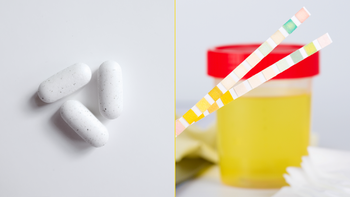
Why Is My Pee Brown? Causes of Dark Pee
Key takeaways:
Urine can take on many colors. But it might feel uncomfortable or too personal to ask why yours is a certain shade.
Many times, your level of hydration causes a change in the color of your urine. If you’re severely dehydrated, it may even appear brown.
There are other causes of brown pee besides dehydration. Some are harmless, while others, like an infection or blood, can be more serious.
Table of contents
Most people take note of the color of their urine and notice that it can change from day to day. This is a good habit. Your pee can provide some clues about your health and what’s going on inside your body. The color of your urine can tell you more than just how hydrated you are.
Brown pee, in particular, is common and can mean several different things — ranging from harmless to more serious. Several health conditions can lead to brown urine. Some are temporary and treatable, while others long-term and from potentially serious causes. Here are eight causes of brown urine.
1. Diet and hydration
Brown pee isn’t always a cause for concern. If the color is between light brown and dark yellow, it may mean that you’re just a little dehydrated. Even certain foods can give a brown tint to your urine, like rhubarb and fava beans.
Search and compare options
2. Menstruation
If you’re menstruating, you may notice that your urine looks brown when blood mixes in. This is most common at the start or end of menstruation, when your blood can appear more brown than red.
3. Medications
Some medications can change the color of your pee. Medications that can turn your pee brown include:
Senna, a common over-the-counter (OTC) laxative
Phenytoin (Dilantin), an anti-seizure medication
Levodopa, a medication for people with Parkinson’s disease
Antibiotics such as nitrofurantoin (Macrobid) and metronidazole (Flagyl)
Antimalarial medications like chloroquine and primaquine
If you’re concerned about other side effects while taking one of these medications, make sure to reach out to a healthcare professional.
4. Urinary tract infection (UTI)
Urinary tract infections (UTI) may lead to darker-colored urine for different reasons. In most cases, the color change is due to blood in your urine. This can occur when bacteria cause bleeding as they invade and inflame the lining of your urinary tract.
While they are more common in women, men can get UTIs as well.
Medication and urine color: Find out which medications can change the color of your urine.
Why is your pee clear? Clear urine often means that you’re well-hydrated. Learn about other causes of clear pee.
Why does your pee smell? Foods and medications don’t just change how your pee looks — they can also make your pee smell differently.
5. Liver disease
Liver disease, such as cirrhosis or hepatitis, can lead to brown urine. This occurs when your urine has abnormally high levels of bilirubin — a waste product that your liver typically breaks down.
If you have brown urine due to liver disease, you’ll likely have other symptoms related to your condition. Some examples are:
Extreme fatigue
Jaundice (yellowing of your skin)
Nausea or vomiting
Abdominal pain or distention
Weight loss
Swelling of your legs
Read more like this
Explore these related articles, suggested for readers like you.
6. Kidney disease
There are several kidney conditions that can result in brown urine. These include:
End-stage kidney disease or kidney failure: Brown urine can result from the buildup of waste products from when your kidneys aren’t functioning normally.
Post-streptococcal glomerulonephritis: This is a very rare complication of strep throat that’s more common in children.
Kidney stones: As kidney stones move down your urinary tract, they tend to irritate the lining and lead to bleeding. And this can make urine look brown.
7. Rhabdomyolysis
Rhabdomyolysis is a condition that occurs when a lot of muscle breaks down, like after very intense exercise. As muscles break down, they release myoglobin, a dark-colored substance that is excreted in your urine.
During rhabdomyolysis, you’ll likely experience significant body and muscle pain, as well as swelling in your arms and legs.
8. Cancer
The most common cancer that can lead to brown urine is renal cell carcinoma. This cancer can cause blood to leak into your urine. Melanoma can also cause melanin, a dark pigment, to leak into your urine. But this is extremely rare.
What can pee say about your health?
Taking note of the color of your urine can give you clues about your health. Lots of things can change how often you pee, how your pee smells, and how your pee looks — from how much you drink and what you eat to the medications you take.
What color should urine be?
Urine gets its yellow color from urobilin or urochrome, a chemical that’s produced when your body breaks down red blood cells. Your kidneys then remove this chemical from your blood, combine it with water, and excrete it as urine.
In general, the more water you drink, the paler your urine will be. Drinking too much water may cause your urine to look clear. Darker yellow means that you may not be drinking enough fluids. Though, as we’ve seen, hydration is just one of many things that can change the color of your urine. Some foods, vitamins, and medications can make your urine orange or even green.
What to do if you notice brown pee
If you notice that your urine has a dark color but you otherwise feel well, a good first step is to start hydrating. Water is a great option. If the dark color clears and you don’t have any other symptoms, it’s safe to say you’ll be OK. Keep in mind that brown urine might indicate your dehydration is severe.
But if your pee is still dark after you drink a good amount of water, something more serious may be going on. Get medical attention if you have brown urine along with any of the following symptoms:
Fever, which can be a sign of infection
Muscle aches or pain
Persistent vomiting or diarrhea
Abdominal or flank pain
Fatigue or disorientation
Even if you don’t have any of these symptoms and your urine color doesn’t improve within hours when you’re better hydrated, you should reach out to a healthcare professional for further evaluation.
The bottom line
It’s completely normal to check out the color of your urine. In fact, it’s one of the many ways to keep daily tabs on your health. A change in the color and shade of urine is normal. If your pee turns brown, don’t hesitate to talk to your primary care provider about it. And if you have other new symptoms with your brown urine, it’s best to get an evaluation.
Why trust our experts?



References
Centers for Disease Control and Prevention. (20214. About post-streptococcal glomerulonephritis.
Heitz, J. W. (2016). Chapter 37 - Abnormal urine color. Post-Anesthesia Care: Symptoms, Diagnosis, and Management. Cambridge University Press.
Milani, D. A. Q., et al. (2023). Urinalysis. StatPearls.
ScienceDirect. (n.d.). Urine color.
Urology Associates. (2019). What does urine color say about your health?
Viswanathan, S. (2013). Urine bag as a modern day matula. ISRN Nephrology.





























